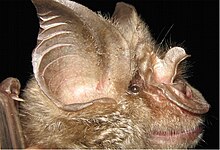Mozambican horseshoe bat
| Mozambican horseshoe bat | |
|---|---|

| |
| Scientific classification | |
| Domain: | Eukaryota |
| Kingdom: | Animalia |
| Phylum: | Chordata |
| Class: | Mammalia |
| Order: | Chiroptera |
| Family: | Rhinolophidae |
| Genus: | Rhinolophus |
| Species: | R. mossambicus
|
| Binomial name | |
| Rhinolophus mossambicus Taylor, Stoffberg, Monadjem, Schoeman, Bayliss & Cotterill, 2012
| |
The Mozambican horseshoe bat (Rhinolophus mossambicus) is a species of horseshoe bat found in Africa.
Taxonomy
[edit]It was described as a new species in 2012. The holotype had been collected by A. Monadjem in July 2006 at Niassa Reserve in Mozambique. It was segregated from the Hildebrandt's horseshoe bat (R. hildebrandtii) species complex at the same time as the Smithers's horseshoe bat, Cohen's horseshoe bat, and Rhinolophus mabuensis. Its species name "mossambicus" refers to the country of Mozambique.[2]
Description
[edit]Its forearm length is 60–65 mm (2.4–2.6 in). It echolocates at a peak frequency of 35-38 kHz.[2]
Range and habitat
[edit]Its range includes the African countries of Mozambique and Zimbabwe. It has been documented at a range of elevations from 60–1,000 m (200–3,280 ft) above sea level.[1] It is associated with savanna habitats.[2]
Conservation
[edit]As of 2017, it is evaluated as a least-concern species by the IUCN. Its population trend is, however, projected as decreasing due to threats such as hunting for bushmeat, as well as roost disturbance due to guano mining.[1]
References
[edit]- ^ a b c Shoeman, C. (2017). "Rhinolophus mossambicus". IUCN Red List of Threatened Species. 2017: e.T64589126A64589338. doi:10.2305/IUCN.UK.2017-2.RLTS.T64589126A64589338.en. Retrieved 19 November 2021.
- ^ a b c Cotterill, Fenton P. D.; Bayliss, Julian; Schoeman, Martinus Corrie; Monadjem, Ara; Stoffberg, Samantha; Taylor, Peter J. (2012-09-12). "Four New Bat Species (Rhinolophus hildebrandtii Complex) Reflect Plio-Pleistocene Divergence of Dwarfs and Giants across an Afromontane Archipelago". PLOS ONE. 7 (9): e41744. Bibcode:2012PLoSO...741744T. doi:10.1371/journal.pone.0041744. ISSN 1932-6203. PMC 3440430. PMID 22984399.

